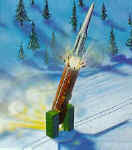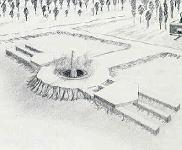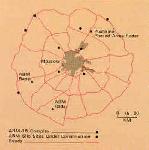

SOVIET STRATEGIC DEFENSE PROGRAMS
October 1985
Preface
In March 1983, President Reagan presented a dramatic new vision of a world in which we would no longer have to depend on nuclear weapons to prevent nuclear conflict. He presented that vision, and that challenge, in this way: What if free people could live secure in the knowledge that their security did not rest upon the threat of instant U.S. retaliation to deter a Soviet attack, that we could intercept and destroy strategic ballistic missiles before they reached our own soil or that of our allies?
The Strategic Defense Initiative (SDI), which the President announced that night, marks the first, essential step toward the realization of his ultimate goal. The SDI is a research program, designed to examine the promise of effective defenses against ballistic missiles based on new and emerging technologies. If such defenses prove feasible, they would provide for a more stable and secure method of preventing war in the future, through the increasing contribution of non-nuclear defenses which threaten no one.
The Strategic Defense Initiative has been the subject of much discussion within the United States and allied countries since its initiation. Such exchanges are essential in our free societies and can only help ensure that the vision behind the research program can be achieved. There has been comparatively little public discussion, however, about the trend in Soviet defensive as well as offensive forces which provides the essential backdrop to the SDI. Indeed, the Soviet Union has intentionally tried to mislead the public about its strategic defense activities.
As this publication documents, Soviet efforts in most phases of strategic defense have long been far more extensive than those of the United States. The USSR has major passive defense programs, designed to protect important assets from attack. It also has extensive active defense systems, which utilize weapons systems to protect national territory, military forces, or key assets. Soviet developments in the area of active defenses fall into three major categories: air defense; ballistic missile defense based on current technologies; and research and development on advanced defenses against ballistic missiles.
Important recent Soviet activities in strategic defenses include:
- Upgrading and expansion of the world's only operational Anti-Ballistic Missile(ABM) system around Moscow;
- Construction of the Krasnoyarsk ballistic missile detection and tracking radar that violates the 1972 ABM Treaty;
- Extensive research into advanced technologies for defense against ballistic missiles including laser weapons, particle beam weapons, and kinetic energy weapons;
- Maintenance of the world's only operational antisatellite (ASAT) system;
- Modernization of their strategic air defense forces; and
- Improvements in their passive defenses by maintaining deep bunkers and blast shelters for key personnel, and enhancing the survivability of some offensive systems through mobility and hardening.
The following pages examine in detail Soviet programs in defenses against ballistic missiles, air defense, and passive defense. A summary of key Soviet offensive force developments is presented in the annex to this document, since those are critical to an understanding of the impact of Soviet strategic defense programs. Soviet offensive forces are designed to be able to limit severely U.S. and allied capability to retaliate against attack. Soviet defensive systems in turn are designed to prevent those retaliatory forces which did survive an attack from destroying Soviet targets.
Given the long-term trend in Soviet offensive and defensive force developments, the United States must act in three main areas to maintain security and stability both in near term and in the future.
First, we must modernize our offensive nuclear forces in order to ensure the essential military balance in the near term, and to provide the incentives necessary for the Soviet Union to join us in negotiating significant, equitable, and verifiable nuclear arms reductions.
Second, we must act now to start constructing a more reliable strategic order for the long term by examining the potential for future effective defenses against ballistic missiles. The Strategic Defense Initiative is a prudent and necessary response to the ongoing extensive Soviet anti-ballistic missile effort, including the existing Soviet deployments permitted under the ABM Treaty. The SDI provides a necessary and powerful deterrent to any near-term Soviet decision to expand rapidly its ABM capability beyond that permitted by the ABM Treaty. The overriding importance of the Strategic Defense Initiative, however, is the promise it offers of moving to a better, more stable basis for deterrence in the future and of providing new and compelling incentives to the Soviet Union to agree to progressively deeper negotiated reduction in offensive nuclear arms.
The third approach is one of negotiation and diplomacy. We are even now looking forward to a transition to a more stable world, with greatly reduced levels of nuclear arms and enhanced ability to deter war based upon the increasing contribution of non-nuclear defenses against offensive nuclear arms. Toward those ends, we are endeavoring at the negotiations in Geneva to achieve significant, equitable, and verifiable reductions in existing nuclear arsenals and to discuss with the Soviets the relationship between offensive and defensive forces and the possibility of a future transition to a more defense-reliant deterrence.
CASPAR W. WEINBERGER
Secretary of Defense
GEORGE P. SHULTZ
Secretary of State
Introduction
In the late 1960s, given the state of defensive technology at the time, the United States came to believe that deterrence could best be assured if each side were able to maintain the ability to threaten retaliation against any attack and thereby impose on an aggressor costs that were clearly beyond any potential gains. That concept called for a reduction by both the Soviet Union and the United States in their strategic defensive forces, the maintenance of a balance between the two sides' offensive nuclear forces, and negotiated nuclear arms reductions which would maintain the balance at progressively lower levels.
In accordance with those principles, the United States exercised great restraint in offensive nuclear arms and at the same time dramatically lowered its defensive forces. Thus, we removed most of our defenses against Soviet bombers; decided to maintain a severely limited civil defense program; ratified the 1972 AntiBallistic Missile (ABM) Treaty, which placed strict limits on U.S. and Soviet defenses against ballistic missiles; and then deactivated the one ABM site which we were allowed under that Treaty. The basic idea that stability and deterrence would be maintained if each side had roughly equal capability to retaliate against attack also served as the foundation for the U.S. approach to the Strategic Arms Limitation Talks (SALT) process of the 1970s.
The Soviet Union, however, failed to show the type of restraint, in both strategic offensive and defensive forces, that the United States hoped for when the SALT process began. The USSR has consistently refused to accept meaningful and verifiable negotiated reductions in offensive nuclear arsenals. Since the late 1960s, the Soviets have greatly expanded and modernized their offensive nuclear forces and invested an approximately equal sum in strategic defenses. The USSR has an extensive, multifaceted operational strategic defensive network which dwarfs that of the United States as well as an active research and development program in both traditional and advanced defenses against ballistic missiles. Soviet noncompliance with arms control agreements in both the offensive and defensive areas, including the ABM Treaty, is a cause of very serious concern. The aggregate of current Soviet ABM and ABM-related activities suggest that the USSR may be preparing an ABM defense of its national territory - precisely what the ABM Treaty was designed to prevent.
Soviet offensive and defensive force developments pose a serious challenge to the West. If left unchecked and unanswered, they would undermine our ability to retaliate effectively in case of Soviet attack. The situation would be even more severe if the Soviet Union were to have a monopoly on advanced defenses against ballistic missiles in addition to its sizable offensive and defensive forces. In that case, the USSR might come to believe that it could launch a nuclear attack against the United States or our allies without fear of effective retaliation. At the very least, it might see a realistic chance of successful nuclear blackmail.
Soviet Strategic Defense Programs
The Soviet Approach
The Soviet emphasis on strategic defense is firmly grounded in Soviet military doctrine and strategy, which call for the following actions in the event of nuclear war:
- destruction and disruption of the West's nuclear-associated command, control, and communications;
destruction or neutralization of as many of the West's nuclear weapons as possible on the ground or at sea before they could be launched;
interception and destruction of surviving weapons - aircraft and missiles - before they reached their targets; and
- protection of the Party, the State, military forces, industrial infrastructure, and the essential working population against those weapons that survived attacks by Soviet offensive forces.
In pursuit of these goals the USSR puts considerable stress on a need for effective strategic defenses as well as offensive forces. In the Soviet view, the USSR could best achieve its aims in any nuclear war if it attacked first, destroying much of the U.S. and allied capability for retaliation. Defensive measures, both active and passive, would in turn prevent those enemy forces that survived a Soviet first-strike from destroying targets in the USSR.
Marshall V. D. Sokolovskiy, in Military Strategy - the basic Soviet strategic treatise, originally published in 1962 - defined the aim of Soviet strategic defenses in this way: "They have the task of creating an invincible system for the defense of the entire country.... While, in the last war, it was sufficient to destroy 15-20 percent of the attacking air operation, now it is necessary to assure, essentially, 100 percent destruction of all attacking airplanes and missiles."
Soviet offensive and defensive force developments over the past 25 years demonstrate that the strategy articulated by Sokolovskiy still applies. The following pages present a detailed description of the actions undertaken by the Soviets in the area of strategic defenses. In order to explain the totality of the Soviet strategic military effort, a description of offensive force developments is provided in the annex to this document.
Defensive Forces
Over the last 25 years the Soviets have increased their active and passive defenses in a clear and determined attempt to blunt the effect of U.S. and allied retaliation to any Soviet attack. Passive defenses are non-weapons measures - such as civil defense and hardening - which protect important assets against attack. Active defenses utilize weapon systems to protect national territory, military forces, or key assets.
Evidence of the importance the Soviets attach to defensive damage-limitation can be traced back to the beginning of the nuclear age. National Air Defense became an independent service in the late 1950s and since 1959 has generally ranked third in precedence within the Soviet Armed Forces, following the Strategic Rocket Forces and the Ground Forces.
By the mid-1960s, two new mission areas - antisatellite defense and anti-missile defense - were added to the National Air Defense mission. As a result, the Soviet Union has the world's only operational anti-satellite (ASAT) system, which has an effective capability to seek and destroy critical U.S. satellites in low earth orbit. In addition, Soviet efforts to attain a viable strategic defense against ballistic missiles have resulted in the world's only operational ABM system and a large and expanding research and development program.
The Soviet emphasis on the necessity of research into defenses against ballistic missiles was demonstrated by then-Minister of Defense Grechko shortly after the signing of the ABM Treaty in 1972, when he told the Soviet Presidium that the Treaty "places no limitations whatsoever on the conducting of research and experimental work directed towards solving the problem of defending the country from nuclear missile strikes."
Ballistic Missile Defense
The Soviets maintain the world's only operational ABM system around Moscow. In 1980, they began to upgrade and expand that system to the limit allowed by the 1972 ABM Treaty.The original single-layer Moscow ABM system included 64 reloadable above-ground launchers at four complexes and DOG HOUSE and CAT HOUSE battle management radars south of Moscow. Each complex consisted of TRY ADD tracking and guidance radars and GALOSH interceptors (nuclear-armed, ground-based missiles designed to intercept warheads in space shortly before they reenter the Earth's atmosphere).
When completed, the modernized Moscow ABM system will be a two-layer defense composed of: silo-based, long-range, modified GALOSH interceptors; silo-based, high-acceleration interceptors designed to engage targets within the atmosphere; associated engagement and guidance radars; and a new large radar at Pushkino designed to control ABM engagements. The silo-based launchers may be reloadable. The new system will have the 100 ABM launchers permitted by the ABM Treaty and could be fully operational by 1987.
 The Soviet system for detection and tracking of ballistic missile attack consists of a launch-detection satellite network, over-the horizon radars, and a series of large phased array radars.
The Soviet system for detection and tracking of ballistic missile attack consists of a launch-detection satellite network, over-the horizon radars, and a series of large phased array radars.
The current launch-detection satellite network can provide about 30 minutes warning of any U.S. ICBM launch and determine the general origin of the missile. Two over-the-horizon radars directed at the U.S. ICBM fields also could give 30 minutes warning.
 The next operational layer of ballistic missile detection consists of 11 large HEN HOUSE ballistic missile early warning radars at six locations on the periphery of the USSR. These radars can distinguish the size of an attack,confirm the warning from the satellite andover-the-horizon radar systems, and provide target-tracking data in support of anti-ballistic missile forces.
The next operational layer of ballistic missile detection consists of 11 large HEN HOUSE ballistic missile early warning radars at six locations on the periphery of the USSR. These radars can distinguish the size of an attack,confirm the warning from the satellite andover-the-horizon radar systems, and provide target-tracking data in support of anti-ballistic missile forces.
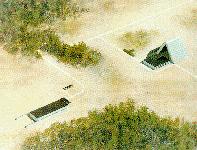 The Soviets are now constructing a network of six new large phased-array radars that can track more ballistic missiles with greater accuracy than the existing HEN HOUSE network. Five of these radars duplicate or supplement the coverage of the HEN HOUSE network, but with greatly enhanced capability. The sixth, under construction near Krasnoyarsk in Siberia, closes the final gap in the Soviet early warning radar coverage against ballistic missile attack. Together, the six new large phased array radars form an arc of coverage from the Kola Peninsula in the northwest Soviet Union, around Siberia, to the Caucasus in the southwest.
The Soviets are now constructing a network of six new large phased-array radars that can track more ballistic missiles with greater accuracy than the existing HEN HOUSE network. Five of these radars duplicate or supplement the coverage of the HEN HOUSE network, but with greatly enhanced capability. The sixth, under construction near Krasnoyarsk in Siberia, closes the final gap in the Soviet early warning radar coverage against ballistic missile attack. Together, the six new large phased array radars form an arc of coverage from the Kola Peninsula in the northwest Soviet Union, around Siberia, to the Caucasus in the southwest.
The United States is now constructing new ballistic missile early warning radars, known as PAVE PAWS, that are located on the periphery of our territory and oriented outward. Both the U.S. and the USSR, in signing the ABM Treaty, recognized the need for ballistic missile early warning radars. At the same time, they recognized that ballistic missile early warning radars can detect and track warheads at great distances and therefore have a significant anti-ballistic missile potential. Such an ABM capability would play an important role in a nationwide ABM defense, which the Treaty was designed to prevent. As a result, the U.S. and the Soviet Union agreed that future ballistic missile early warning radars must be located on a nation's periphery and oriented outward. In that way, the desirable and legitimate goal of early warning could be advanced while minimizing the danger that an effective nationwide battle management network could result.
The Krasnoyarsk radar is designed for ballistic missile detection and tracking, including ballistic missile early warning, and violates the 1972 ABM Treaty. It is not located within a 150-kilometer radius of the national capital (Moscow) as required of ABM radars, or is it located on the periphery of the Soviet Union and pointed outward as required or early warning radars. It is 3,700 kilometers from Moscow and is situated some 750 kilometers from the nearest border - Mongolia. Moreover, it is oriented not toward that border, but across approximately 4,000 kilometers of Soviet territory to the northeast.
 The Soviet Union has claimed that the Krasnoyarsk radar is designed for space tracking, rather than ballistic missile early warning, and therefore does not violate the ABM Treaty. Its design, however, is not optimized for a space tracking role, and the radar would, in any event, contribute little to the existing Soviet
space tracking network. Indeed, the design of the Krasnoyarsk radar is essentially identical to that of other radars that are known -
and acknowledged by the Soviets - to be for ballistic missile detection and tracking, including ballistic missile early warning. Finally, it
closes the last remaining gap in Soviet ballistic missile detection coverage. The Krasnoyarsk radar, therefore, is being constructed in direct violation of the ABM Treaty.
The Soviet Union has claimed that the Krasnoyarsk radar is designed for space tracking, rather than ballistic missile early warning, and therefore does not violate the ABM Treaty. Its design, however, is not optimized for a space tracking role, and the radar would, in any event, contribute little to the existing Soviet
space tracking network. Indeed, the design of the Krasnoyarsk radar is essentially identical to that of other radars that are known -
and acknowledged by the Soviets - to be for ballistic missile detection and tracking, including ballistic missile early warning. Finally, it
closes the last remaining gap in Soviet ballistic missile detection coverage. The Krasnoyarsk radar, therefore, is being constructed in direct violation of the ABM Treaty.
 The growing Soviet network of large phased array ballistic missile detection and tracking radars, of which the Krasnoyarsk radar is apart, is of particular concern when linked with other Soviet ABM efforts. Such radars take years to construct; their existence might allow the Soviet Union to move rather quickly to construct a nationwide ABM defense if it chooses to do so. The Soviets are also developing components of a new ABM system which apparently are designed to allow them to construct individual ABM sites in a matter of months, rather than the years that are required for more traditional ABM systems. Soviet activities in this regard potentially violate the ABM Treaty's prohibition on the development of a mobile land-based ABM system or components. We estimate that by using these components, the Soviets could undertake rapidly-paced ABM deployments to strengthen the defenses of Moscow and defend key targets in the western USSR and east of the Urals by the early 1990s.
The growing Soviet network of large phased array ballistic missile detection and tracking radars, of which the Krasnoyarsk radar is apart, is of particular concern when linked with other Soviet ABM efforts. Such radars take years to construct; their existence might allow the Soviet Union to move rather quickly to construct a nationwide ABM defense if it chooses to do so. The Soviets are also developing components of a new ABM system which apparently are designed to allow them to construct individual ABM sites in a matter of months, rather than the years that are required for more traditional ABM systems. Soviet activities in this regard potentially violate the ABM Treaty's prohibition on the development of a mobile land-based ABM system or components. We estimate that by using these components, the Soviets could undertake rapidly-paced ABM deployments to strengthen the defenses of Moscow and defend key targets in the western USSR and east of the Urals by the early 1990s.
In addition, the Soviets have probably violated the prohibition on testing surface-to-air missile (SAM) components in an ABM mode by conducting tests involving the use of SAM air defense radars in ABM-related testing activities. Moreover, the SA-10 and SA-X-12 SAM systems may have the potential to intercept some types of strategic ballistic missiles.
Taken together, all of the Soviet Union's ABM and ABM-related activities are more significant - and more ominous - than anyone considered individually. Cumulatively, they suggest that the USSR may be preparing an ABM defense of its national territory.
Advanced Technologies for Defense Against Ballistic Missiles
In the late 1960s, in line with its long-standing emphasis on strategic defense, the Soviet Union initiated a substantial research program into advanced technologies for defense against ballistic missiles. That program covers many of the same technologies involved in the U.S. Strategic Defense Initiative, but represents a far greater investment of plant space, capital, and manpower.
Laser Weapons
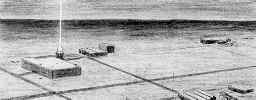 The USSR's laser program is much larger than U.S. efforts and involves over 10,000 scientists and engineers and more than a half dozen major research and development facilities and test ranges. Much of this research takes place at the Sary Shagan Missile Test Center where the Soviets also conduct traditional ABM research. Facilities there are estimated to 1include several air defense lasers, a laser that may be capable of damaging some components of satellites in orbit, and a laser that could be used in feasibility testing for ballistic missile defense applications. A laser weapon program of the magnitude of the Soviet effort would cost roughly $1 billion per year in the U.S.
The USSR's laser program is much larger than U.S. efforts and involves over 10,000 scientists and engineers and more than a half dozen major research and development facilities and test ranges. Much of this research takes place at the Sary Shagan Missile Test Center where the Soviets also conduct traditional ABM research. Facilities there are estimated to 1include several air defense lasers, a laser that may be capable of damaging some components of satellites in orbit, and a laser that could be used in feasibility testing for ballistic missile defense applications. A laser weapon program of the magnitude of the Soviet effort would cost roughly $1 billion per year in the U.S.
The Soviets are conducting research in three types of gas lasers considered promising for weapons applications: the gas-dynamic laser; the electric discharge laser; and the chemical laser. Soviet achievements in this area, in terms of output power, have been impressive. The Soviets are also aware of the military potential of visible and very short wave-length lasers. They are investigating excimer, free electron, and x-ray lasers, and have been developing argon-ion lasers for over a decade.
The Soviets appear generally capable of supplying the prime power, energy storage, and auxiliary components needed for most laser and other directed-energy weapons. They have developed a rocket-driven magnetohydrodynamic generator which produces over 15 megawatts of electrical power - a device that has no counterpart in the West. The Soviets may also have the capability to develop the optical systems necessary for laser weapons to track and attack their targets. Thus, they produced a 1.2-meter segmented mirror for an astrophysical telescope in 1978 and claimed that this was a prototype for a 25-meter mirror that would be constructed in the future. A large mirror is considered necessary for a space-based laser weapon.
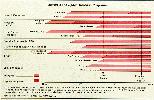 Unlike the U.S., the USSR has now progressed in some cases beyond technology research. It already has ground-based lasers that could be used to interfere with U.S. satellites, and could have prototype space-based antisatellite laser weapons by the end of the decade. The Soviets could have prototypes for ground-based lasers for defense against ballistic missiles by the late 1980s, and could begin testing components for a large-scale deployment system in the early 1990s.
Unlike the U.S., the USSR has now progressed in some cases beyond technology research. It already has ground-based lasers that could be used to interfere with U.S. satellites, and could have prototype space-based antisatellite laser weapons by the end of the decade. The Soviets could have prototypes for ground-based lasers for defense against ballistic missiles by the late 1980s, and could begin testing components for a large-scale deployment system in the early 1990s.
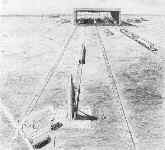 The remaining difficulties in fielding an operational system will require still more development time. An operational ground-based laser for defense against ballistic missiles probably could not be deployed until the late 1990s, or after the year 2000. If technology developments prove successful, the Soviets may deploy operational space-based antisatellite lasers in the 1990s, and might be able to deploy space-based laser systems for defense against ballistic missiles after the year 2000.
The remaining difficulties in fielding an operational system will require still more development time. An operational ground-based laser for defense against ballistic missiles probably could not be deployed until the late 1990s, or after the year 2000. If technology developments prove successful, the Soviets may deploy operational space-based antisatellite lasers in the 1990s, and might be able to deploy space-based laser systems for defense against ballistic missiles after the year 2000.
Particle Beam Weapons
Since the late 1960s, the Soviets have been involved in research to explore the feasibility of space-based weapons that would use particle beams. We estimate that they may be able to test a prototype particle beam weapon intended to disrupt the electronics of satellites in the 1990s. A weapon designed to destroy satellites could follow later. A weapon capable of physically destroying missile boosters or warheads probably would require several additional years of research and development.
It is still uncertain whether ground-based charged particle-beam weapons are feasible - that is, whether the beam will propagate in the atmosphere. A space-based neutral particle beam weapon, however, would not be affected by the atmosphere or by the earth's magnetic field.
Soviet efforts in particle beams, and particularly on ion sources and radio frequency quadrupole accelerators for particle beams, are very impressive. In fact, much of the U.S. understanding as to how particle beams could be made into practical defensive weapons is based on Soviet work conducted in the late 1960s and early 1970s.
Radio Frequency Weapons
The USSR has conducted research in the use of strong radio frequency signals that have the potential to interfere with or destroy critical electronic components of ballistic missile warheads. The Soviets could test a ground-based radio frequency weapon capable of damaging satellites in the 1990s.
Kinetic Energy Weapons
 The Soviets also have a variety of research programs underway in the area of kinetic energy weapons, using the high-speed collision of a small mass with the target as the kill mechanism. In the 1960s, the USSR developed an experimental "gun" that could shoot streams of particles of a heavy metal such as tungsten or molybdenum at speeds of nearly 25 kilometers per second in air and over 60 kilometers per second in a vacuum.
The Soviets also have a variety of research programs underway in the area of kinetic energy weapons, using the high-speed collision of a small mass with the target as the kill mechanism. In the 1960s, the USSR developed an experimental "gun" that could shoot streams of particles of a heavy metal such as tungsten or molybdenum at speeds of nearly 25 kilometers per second in air and over 60 kilometers per second in a vacuum.
Long-range, space-based kinetic-energy systems for defense against ballistic missiles probably could not be developed until the mid 1990s or even later. The USSR could, however, deploy in the near-term a short-range, space-based system useful for satellite or space station defense or for close-in attack by a maneuvering satellite. Soviet capabilities in guidance and control systems probably are adequate for effective kinetic energy weapons for use against some objects in space.
Computer and Sensor Technology
Advanced weapons programs - including potential advanced defenses against ballistic missiles - are also dependent on remote sensor and computer technologies which are currently more highly developed in the West than in the Soviet Union. The Soviets are therefore devoting considerable resources to improving their abilities and expertise in these technologies. An important part of that effort involves an increasing exploitation of open and clandestine access to Western technology. For example, the Soviets have long been engaged in a well funded effort to purchase U.S. high-technology computers, test and calibration equipment, and sensors illegally through third parties.
Antisatellite Developments
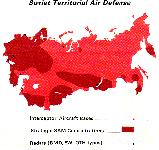 The USSR has had for more than a dozen years the world's only operational antisatellite system, a co-orbital device which enters into the same orbit as its target satellite and, when it gets close enough, destroys the satellite by exploding a conventional warhead. In addition, the nuclear-armed GALOSH ABM interceptor deployed around Moscow may have ASAT capability, and Soviet ground-based lasers could possibly damage some sensors on some U.S. satellites.
The USSR has had for more than a dozen years the world's only operational antisatellite system, a co-orbital device which enters into the same orbit as its target satellite and, when it gets close enough, destroys the satellite by exploding a conventional warhead. In addition, the nuclear-armed GALOSH ABM interceptor deployed around Moscow may have ASAT capability, and Soviet ground-based lasers could possibly damage some sensors on some U.S. satellites.
Furthermore, as noted earlier, the Soviets are engaged in research and, in some cases development, of weapons which ultimately may serve as ballistic missile defense systems, but probably will first provide antisatellite capabilities.
Air Defense
Although the United States began dismantling most of its defenses against Soviet bombers in the 1960s, the Soviet Union has continued to invest enormous resources in a wide array of strategic air defense weapon systems. Taken together, the Soviet strategic air defense network is a potent and increasingly capable force which would attempt to limit the retaliatory capability of our strategic bombers and cruise missiles.
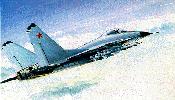 The Soviets have deployed numerous strategic air defense systems with excellent capabilities against aircraft flying at medium and high altitudes. They are now in the midst of a major program to improve their capabilities against aircraft and cruise missiles that fly at low altitudes. That effort includes partial integration of strategic and tactical air defenses, the upgrading of early warning and surveillance capabilities, the deployment of more efficient data transmission systems, and the development and initial deployment of new aircraft, associated air-to-air missiles, surface-to-air missiles, and airborne warning and control system (AWACS)aircraft.
The Soviets have deployed numerous strategic air defense systems with excellent capabilities against aircraft flying at medium and high altitudes. They are now in the midst of a major program to improve their capabilities against aircraft and cruise missiles that fly at low altitudes. That effort includes partial integration of strategic and tactical air defenses, the upgrading of early warning and surveillance capabilities, the deployment of more efficient data transmission systems, and the development and initial deployment of new aircraft, associated air-to-air missiles, surface-to-air missiles, and airborne warning and control system (AWACS)aircraft.
Currently, the Soviets have nearly 12,000 SAM launchers at over 1,200 sites, 10,000 air defense radars, and more than 1,200 interceptor aircraft dedicated to strategic defense. An additional 2,800 interceptors assigned to Soviet Air Forces (SAF) could also be employed in strategic defense missions. In contrast, the U.S. has approximately 300 interceptor aircraft based in the U.S. dedicated to strategic defense, 118 strategic air defense warning radars, and no operational strategic surface-to-air missile launchers. These figures do not include tactical air defenses deployed by NATO and the Warsaw Pact in Europe.
 The newest Soviet air defense interceptor aircraft, the MiG-31/FOXHOUND, has a look-down/shoot-down and multiple-target engagement capability. More than 85 FOXHOUNDS are now operationally deployed at several locations from the Arkhangelsk area in the northwestern USSR to the Far East Military District. Two new fighter interceptors, the Su-27/FLANKER and the MiG-29/FULCRUM, also have look-down/shoot-down capabilities and are designed to be highly maneuverable
in air-to-air combat. These three aircraft are equipped with two new air-to-air missiles - the long-range AA-9 (for the FOXHOUND) and the medium-range AA-10 (for the FULCRUM and FLANKER) - that can be used against low flying targets.
The newest Soviet air defense interceptor aircraft, the MiG-31/FOXHOUND, has a look-down/shoot-down and multiple-target engagement capability. More than 85 FOXHOUNDS are now operationally deployed at several locations from the Arkhangelsk area in the northwestern USSR to the Far East Military District. Two new fighter interceptors, the Su-27/FLANKER and the MiG-29/FULCRUM, also have look-down/shoot-down capabilities and are designed to be highly maneuverable
in air-to-air combat. These three aircraft are equipped with two new air-to-air missiles - the long-range AA-9 (for the FOXHOUND) and the medium-range AA-10 (for the FULCRUM and FLANKER) - that can be used against low flying targets.
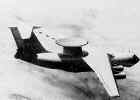 The USSR is also deploying the MAINSTAY airborne warning and control system (AWACS) aircraft, which will improve substantially its capabilities for early warning and air combat command and control, especially against low flying aircraft and cruise missiles.
The USSR is also deploying the MAINSTAY airborne warning and control system (AWACS) aircraft, which will improve substantially its capabilities for early warning and air combat command and control, especially against low flying aircraft and cruise missiles.
The Soviets maintain the world's most extensive early warning system for air defense, composed of a widespread network of ground-based radars linked operationally with those of their Warsaw Pact allies. As previously noted, more than 10,000 air surveillance radars of various types provide virtually complete coverage at medium to high altitudes over the USSR, and in some areas well beyond the Soviet Union's borders. Three over-the-horizon radars for ballistic missile warning could provide additional warning of the approach of high-flying aircraft.
The USSR also has an active research and development program to improve its air surveillance network. In 1983, it began to deploy two new types of air surveillance radars which will enhance Soviet capabilities for air defense, electronic warfare and early warning of cruise missile and bomber attacks. The Soviets are also continuing to deploy improved air surveillance data systems that can rapidly pass data from outlying radars through the air surveillance network to ground-controlled intercept sites and SAM command posts.
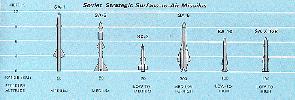 Soviet strategic surface-to-air missiles provide low-to-high-altitude barrier, area, and terminal defenses under all weather conditions. Five systems are now operational: the SA-1, SA-2, and SA-3, and the more capable SA-5 and SA-10. The recent Soviet air defense reorganization permits efficient integration of strategic and tactical SAM systems. While most tactical SAMs have a shorter range than their strategic counterparts, many have better capabilities against targets flying at low altitude.
Soviet strategic surface-to-air missiles provide low-to-high-altitude barrier, area, and terminal defenses under all weather conditions. Five systems are now operational: the SA-1, SA-2, and SA-3, and the more capable SA-5 and SA-10. The recent Soviet air defense reorganization permits efficient integration of strategic and tactical SAM systems. While most tactical SAMs have a shorter range than their strategic counterparts, many have better capabilities against targets flying at low altitude.
Over the years the Soviets have continued to deploy the long-range SA-5 and have repeatedly modified the system. Further deployment and upgrading of the SA-5 to enhance its capability to work in conjunction with low-altitude systems like the SA-10 are probable.
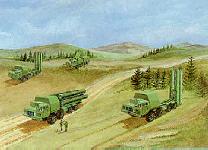 The SA-10 can defend against low-altitude targets with small radar cross-sections, like cruise missiles. The first SA-10 site was operational in 1980. Over 60 sites are now operational and work is progressing on at least another 30. More than half these sites are located near Moscow; this emphasis on Moscow and the patterns noted for the other SA-10 sites suggest a first priority on terminal defense of command and control, military, and key industrial complexes.
The SA-10 can defend against low-altitude targets with small radar cross-sections, like cruise missiles. The first SA-10 site was operational in 1980. Over 60 sites are now operational and work is progressing on at least another 30. More than half these sites are located near Moscow; this emphasis on Moscow and the patterns noted for the other SA-10 sites suggest a first priority on terminal defense of command and control, military, and key industrial complexes.
In keeping with their drive toward mobility as a means of weapons survival, the Soviets are developing a mobile version of the SA-10 which could become operational late this year. This mobile version could be used to support Soviet theater forces and to permit periodic changes in the location of SA-10 sites within the USSR so as to counter U.S. retaliatory forces more effectively.
 The Soviets are also flight-testing another important mobile SAM system, the SA-X-12, which is able to intercept aircraft at all altitudes, cruise missiles, and short-range ballistic missiles. The SA-10 and SA-X-12 may have the potential to intercept some types of strategic ballistic missiles as well. This is a serious development because these systems are expected to be deployed widely through
out the Soviet Union in the 1980s. They could, if properly supported, add a significant point target defense coverage to a nationwide Soviet ABM deployment.
The Soviets are also flight-testing another important mobile SAM system, the SA-X-12, which is able to intercept aircraft at all altitudes, cruise missiles, and short-range ballistic missiles. The SA-10 and SA-X-12 may have the potential to intercept some types of strategic ballistic missiles as well. This is a serious development because these systems are expected to be deployed widely through
out the Soviet Union in the 1980s. They could, if properly supported, add a significant point target defense coverage to a nationwide Soviet ABM deployment.
Passive Defenses
Soviet military doctrine calls for passive defenses to act in conjunction with active forces to ensure the wartime survival and continuity of Soviet nuclear forces, leadership, military command and control units, war-related industrial production and services, the essential work force, and as much of the general population as possible. The U.S. passive defense effort is far smaller and more limited; it is no way comparable to the comprehensive Soviet program.
Physical hardening of military assets to make them more resistant to attack is an important passive defense technique. The USSR has hardened its ICBM silos, launch facilities,and key command and control centers to an unprecedented degree. Much of today's U.S. retaliatory force would be ineffective against those hardened targets. To maintain effective deterrence, the United States must be able credibly to threaten prompt retaliation against the full spectrum of Soviet targets, including those which have been greatly hardened.
Soviet leaders and managers at all levels of the government and Communist Party are provided hardened alternate command posts located well away from urban centers - in addition to many deep bunkers and blast shelters in Soviet cities. This comprehensive and redundant system, patterned after a similar system for the Soviet Armed Forces, provides hardened alternate facilities for more than 175,000 key party and government personnel throughout the USSR.
Elaborate plans have also been made for the full mobilization of the national economy in support of a war effort. Reserves of vital materials are maintained, many in hardened underground structures. Redundant industrial facilities are in active production. Industrial and other economic facilities have been equipped with blast shelters for the work force, and detailed procedures have been developed for the relocation of selected plants and equipment. By planning for the survival of the essential work force, the Soviets hope to reconstitute vital production programs using those industrial components that could be redirected or salvaged after an attack.
In addition, the USSR has greatly emphasized mobility as a means of enhancing the survivability of military assets. The SS-20 and SS-25, for example, are mobile. Rail-mobile deployment of the SS-X-24 is expected before the end of the decade. The Soviets are also developing an extensive network of mobile command, control, and communications facilities.
Soviet Statements on the U.S. Strategic Defense Initiative
These extensive Soviet activities in strategic defense, combined with the large Soviet buildup in offensive forces over the past two decades, have been eroding the retaliatory capabilities of U.S. strategic forces on which deterrence has long rested. If the USSR in the future were unilaterally to add an effective advanced defense against ballistic missiles to its offensive and other defensive forces, it would pose a very serious new threat to U.S. and allied security.
The U.S. Strategic Defense Initiative is designed to counter the trend in the Soviets' favor. It is thus not unexpected that Soviet reactions to the U.S. Strategic Defense Initiative have been strongly negative. Through an intensive, worldwide propaganda campaign, the USSR evidently hopes that it can dissuade the United States from pursuing this research program, thereby preserving the possibility of a Soviet monopoly in effective defenses against ballistic missiles - a monopoly that could give the USSR the uncontested damage-limiting first-strike capability that it has long sought.
Thus, Soviet statements on the SDI must be seen in light of the extensive, long-term growth in Soviet offensive and defensive forces and of their major research effort to develop advanced weapons for defense against ballistic missiles. They should also be viewed in light of comparable Soviet propaganda campaigns on other issues. The USSR engaged in a major propaganda effort in the late 1970s and early 1980s to preserve its monopoly in longer range intermediate-range nuclear forces, and has adopted many of the same tactics to prevent the United States from acquiring an operational ASAT system to balance its own.
On April 22, 1983, a month after the President's announcement of the Strategic Defense Initiative, a published letter signed by more than 200 senior Soviet scientists denouncing the initiative appeared in the New York Times. It is interesting and instructive to note that a number of the signatories have been instrumental in the development of both traditional and advanced ballistic missile defensive systems: Petr D. Grushin, Vladimir S. Semenikhin, Fedor V. Bunkin, Yevgeniy P. Velikhov, Vsevolod S. Avduyevskiy, Aleksandr M. Prokhorov, and Nikolay G. Basov. Velikhov, for example, was for  several years the director of the Institute of Atomic Energy laboratories at Troitsk,
where lasers for strategic and tactical applications are being developed. Avduyevskiy has long been involved with strategic weapons research and now has responsibility for a number of projects concerned with the military use of space, including a space-based laser weapon. Other signatories have spent their careers developing strategic offensive weapons and other military systems: Vladimir N. Chelomey, Valentin P. Glushko, Aleksandr D. Nadiradze, and Viktor P. Makeyev in ICBMs and SLBMs; Oleg K. Antonov and Aleksandr S.Yakovlev in military aircraft; Nikolay Isaninin nuclear submarines; Yuliy B. Khariton in the Soviet military nuclear energy program; and Martin I. Kabachnik in chemical warfare.
several years the director of the Institute of Atomic Energy laboratories at Troitsk,
where lasers for strategic and tactical applications are being developed. Avduyevskiy has long been involved with strategic weapons research and now has responsibility for a number of projects concerned with the military use of space, including a space-based laser weapon. Other signatories have spent their careers developing strategic offensive weapons and other military systems: Vladimir N. Chelomey, Valentin P. Glushko, Aleksandr D. Nadiradze, and Viktor P. Makeyev in ICBMs and SLBMs; Oleg K. Antonov and Aleksandr S.Yakovlev in military aircraft; Nikolay Isaninin nuclear submarines; Yuliy B. Khariton in the Soviet military nuclear energy program; and Martin I. Kabachnik in chemical warfare.
The U.S. Strategic Defense Initiative
The U.S. Strategic Defense Initiative offers the possibility of a better, more stable deterrence based increasingly on defenses that are survivable, militarily effective, and cost effective relative to offensive forces. If our research shows that such defenses against ballistic missiles are feasible, they would allow us to move from deterrence based solely on the threat of nuclear retaliation, toward enhanced deterrence characterized by greater reliance on defensive capabilities that threaten no one. The Strategic Defense Initiative is also a prudent and necessary response to the very active Soviet efforts in offensive and defensive forces. It responds directly to the ongoing and extensive Soviet anti-ballistic missile effort, including the existing Soviet deployments permitted under the ABM Treaty. The SDI research program provides a necessary and powerful deterrent to any near-term Soviet decision to expand rapidly its ABM capability beyond that contemplated by the ABM Treaty. It also provides insurance against an eventual Soviet attempt to deploy an effective advanced system for defense against ballistic missiles unilaterally.
SDI research complements our efforts to achieve significant, equitable, and verifiable reductions in nuclear forces. In the near term, we are seeking reductions of strategic and intermediate-range nuclear forces, and discussing defensive and space arms, in the U.S. Soviet negotiations which opened in Geneva in March 1985. The United States and the Soviet Union have agreed that there is a fundamental relationship between offensive and defensive systems and that neither can be considered in isolation.
In the longer term, if we were to deploy advanced defenses against ballistic missiles, such defenses could increase significantly the incentives for further negotiated deep reductions in offensive nuclear forces because they could reduce or eliminate the military utility of ballistic missiles. Such significant reductions would, in turn, serve to increase the effectiveness of defensive systems.
The SDI research program emphasizes advanced non-nuclear defensive technologies. It will provide to a future President and Congress, possibly in the early 1990s, the technical knowledge required for a decision on whether to develop and later deploy advanced defensive systems. Extensive discussions with our allies would take place prior to any future decision to move beyond research to development and deployment.
Any future deployment would also be a matter for discussion and negotiation as appropriate with the Soviet Union, as provided in the ABM Treaty. Even now we are seeking to engage the Soviets at Geneva in a discussion of the relationship of offensive and defensive forces and of a possible future transition to greater reliance on defensive systems.
While we could not allow a Soviet veto over a decision which would have such a major impact on U.S. and allied security, it is our intention and hope that - if new defensive technologies prove feasible - we and the Soviets would be able both to move to a more defense reliant balance. What we envision is thus just the opposite of an arms race or a search for military superiority. We seek instead an approach that would serve the security interests of the United States, our allies, the Soviet Union, and the world as a whole.
ANNEX
Offensive Forces
Soviet military doctrine and strategy call for superior offensive forces capable of executing a successful first strike. The Soviet buildup inoffensive forces over the last two decades has been designed to move in that direction.
Soviet strategic offensive forces introducedsince 1971 include:
- four new types of intercontinental ballistic missiles (ICBMs) - the SS-17,18, 19, and 25. In addition, the USSR probably has deployed the SS-16 in violation of the SALT II Treaty;
- five new types of ballistic missile-carrying submarines;
- four new types of submarine-launched ballistic missiles (SLBMs);
- five improved versions of existing SLBMs;
- long-range cruise missiles; and a new variant of the BEAR bomber carrying strategic air-launched cruise
That buildup is all the more striking when compared to the relative restraint exercised by the U.S. in its acquisition of nuclear weapons systems during the same period. The number of strategic and tactical nuclear warheads in the U.S. stockpile peaked in 1967. We had one-third more nuclear weapons then than we have now.Moreover, the total explosive power (measured in megatonnage) of our nuclear weapons was four times greater in 1960 than it is today.
Our latest B-52 bomber was built in 1962. Although we modernized the missiles our submarines carried with the POSEIDON C-3 in 1971 and TRIDENT I C-4 in 1979, we did not introduce a single new ballistic missile-carrying submarine from 1966 until 1981, when we began deploying the TRIDENT submarine at the rate of about one a year. In fact, our ballistic missile submarine force declined by one-fourth between 1966 and 1981, from 41 boats to 31.During the time we were decreasing the number of our SSBNs, the Soviet Union deployed 62 new ballistic missile-carrying submarines.
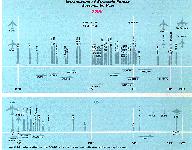 Similarly, the U.S. began deploying its newest ICBM, the MINUTEMAN III, fifteen years ago; today, we have fewer ICBMs than we did in 1967. By contrast, the Soviet Union has added about 800 ICBMs to its arsenal since that year. Of greatest concern for strategic stability has been the development and deployment of the SS-18 and SS-19 ICBMs. Since the late 1970s, the USSR has deployed more than 300 SS-18s, each twice as large as the U.S.PEACEKEEPER/MX and carrying ten warheads, and 360 SS-19s, each approximately the size of the PEACEKEEPER/MX and carrying six warheads. The Soviets already have enough hard-target-capable ICBM warheads today to attack all U.S. ICBM silos and launch control centers and will have a larger number of hard-target capable warheads in the future. (A weapon with hard-target capability has sufficient accuracy and yield to destroy targets that have been hardened to withstand the effects of a nuclear detonation.)
Similarly, the U.S. began deploying its newest ICBM, the MINUTEMAN III, fifteen years ago; today, we have fewer ICBMs than we did in 1967. By contrast, the Soviet Union has added about 800 ICBMs to its arsenal since that year. Of greatest concern for strategic stability has been the development and deployment of the SS-18 and SS-19 ICBMs. Since the late 1970s, the USSR has deployed more than 300 SS-18s, each twice as large as the U.S.PEACEKEEPER/MX and carrying ten warheads, and 360 SS-19s, each approximately the size of the PEACEKEEPER/MX and carrying six warheads. The Soviets already have enough hard-target-capable ICBM warheads today to attack all U.S. ICBM silos and launch control centers and will have a larger number of hard-target capable warheads in the future. (A weapon with hard-target capability has sufficient accuracy and yield to destroy targets that have been hardened to withstand the effects of a nuclear detonation.)
In addition to the rapid growth in its ICBM force, the Soviet Union is engaged in a major modernization and expansion of its strategic bomber and submarine forces. The bulk of Soviet strategic offensive nuclear warheads has traditionally been on ICBMs, while the U.S. has maintained a balanced force, with fewer than one-quarter of our strategic weapons on ICBMs. The growth in modern Soviet strategic offensive forces of all types is thus not only exacerbating the imbalance between U.S. and Soviet ICBMs, but also steadily eroding the traditional countervailing U.S. advantage in SLBMs and strategic bomber systems.
When the SALT I Interim Agreement on Offensive Arms was signed in 1972, the USSR had roughly 2,300 strategic ballistic missile warheads, and the throw-weight of its ballistic missile force was about 3 million kilograms. (Throw-weight is a basic measure of ballistic missile destructive capability and potential.) By the time the SALT II agreement was signed in 1979, the Soviet strategic arsenal had more than doubled to roughly 5,500 strategic ballistic missile warheads with a ballistic missile throw-weight of about 4 million kilograms. Today, the Soviet Union has over 8,000 strategic ballistic missile warheads and a ballistic missile throw-weight of about 12 million kilograms.
Perhaps even more troubling is the fact that the USSR's offensive nuclear force buildup continues unabated, with a large number of new systems at or nearing deployment. For example, the Soviets are:
- continuing production of the BEAR H bombers which carry the AS-15 long-range air-launched cruise missile. They are also developing a new strategic bomber, the BLACKJACK, which, when deployed before the end of the decade, will be larger than either the U.S. B-1B or B-52;
- completing development of the SS-X-24 and have announced deployment of the SS-25 ICBM. The SS-25 violates the SALT II agreement, since it is a prohibited second new type of ICBM;
- deploying two new classes of nuclear powered ballistic missile-carrying submarines (SSBNs), the DELTA IV and the TYPHOON, and associated SLBMs. They are also testing a new sea-launched cruise missile, the SS-NX-21.
The combination of U.S. restraint and Soviet expansion and modernization of its strategic offensive forces means that U.S. forces are becoming increasingly obsolete. We are therefore modernizing our strategic nuclear forces to ensure the balance necessary for continued deterrence. That program includes development of the PEACEKEEPER/MX ICBM, a smaller single-warhead ICBM (popularly known as MIDGETMAN), the B-1B bomber, an advanced technology bomber, and the TRIDENT II SLBM. We are also deploying long-range air and sea-launched cruise missiles and TRIDENT SSBNs. Our strategic modernization program is essential not only for the military balance, but also to induce the Soviets to agree to negotiated offensive force reductions which would enable us to maintain the balance at far lower levels of armaments.
The Soviet Union has also greatly expanded its nuclear forces of less-than-intercontinental range, which primarily threaten our friends and allies. The USSR has developed an entirely new generation of nuclear short-range ballistic missiles. Of gravest concern has been the creation and subsequent rapid expansion of the SS-20 longer-range intermediate-range missile force, which threatens our friends and allies in Europe and Asia. NATO had no equivalent systems when the USSR began to field this modern, mobile, highly accurate, triple warhead missile. As of September 1985, the Soviets had deployed 441 SS-20s, with over 1,200warheads. Not only is the SS-20 force continuing to grow, but the Soviets are also testing a modified version of the SS-20 which is expected to be even more accurate. In contrast, NATO plans to deploy 572 single-warhead PERSHING II and ground-launched cruise missiles and stands ready to reduce or reverse those deployments if we can reach an equitable, verifiable arms reduction agreement with the USSR.

